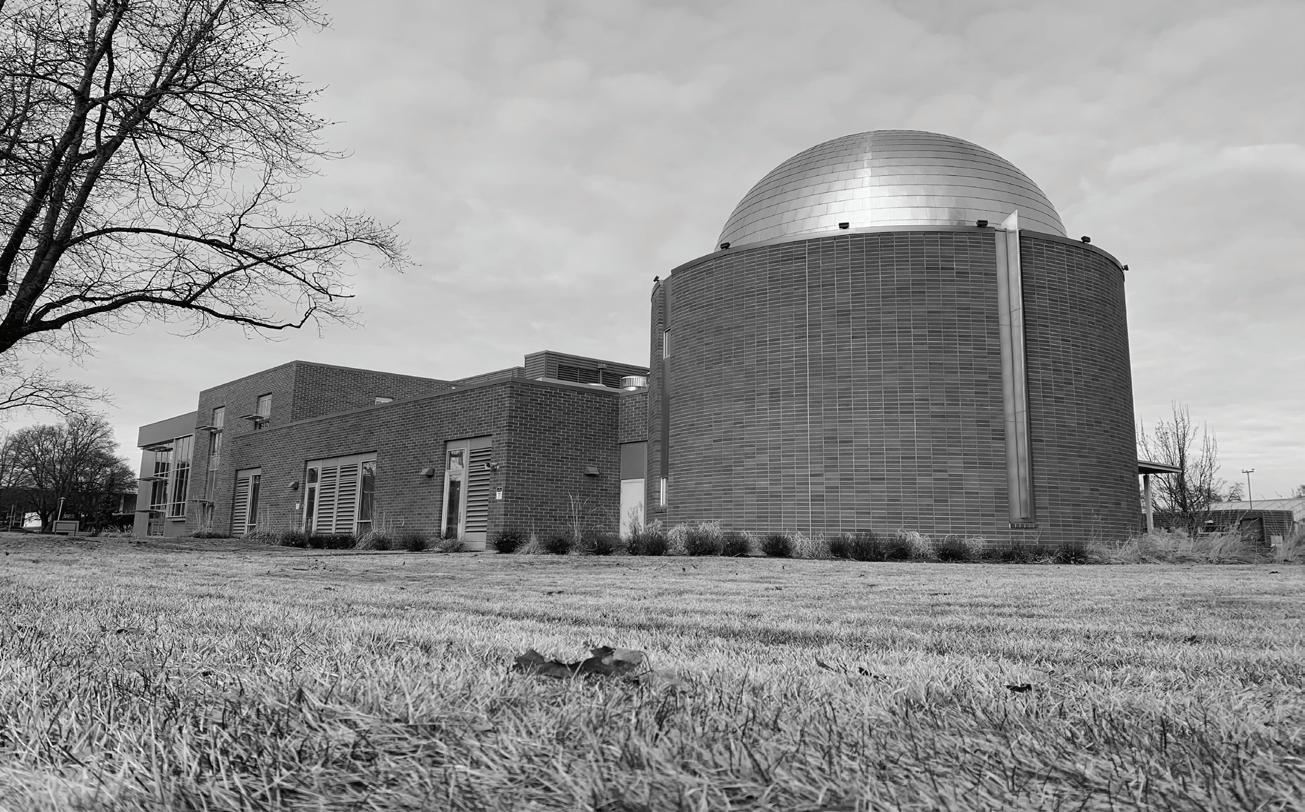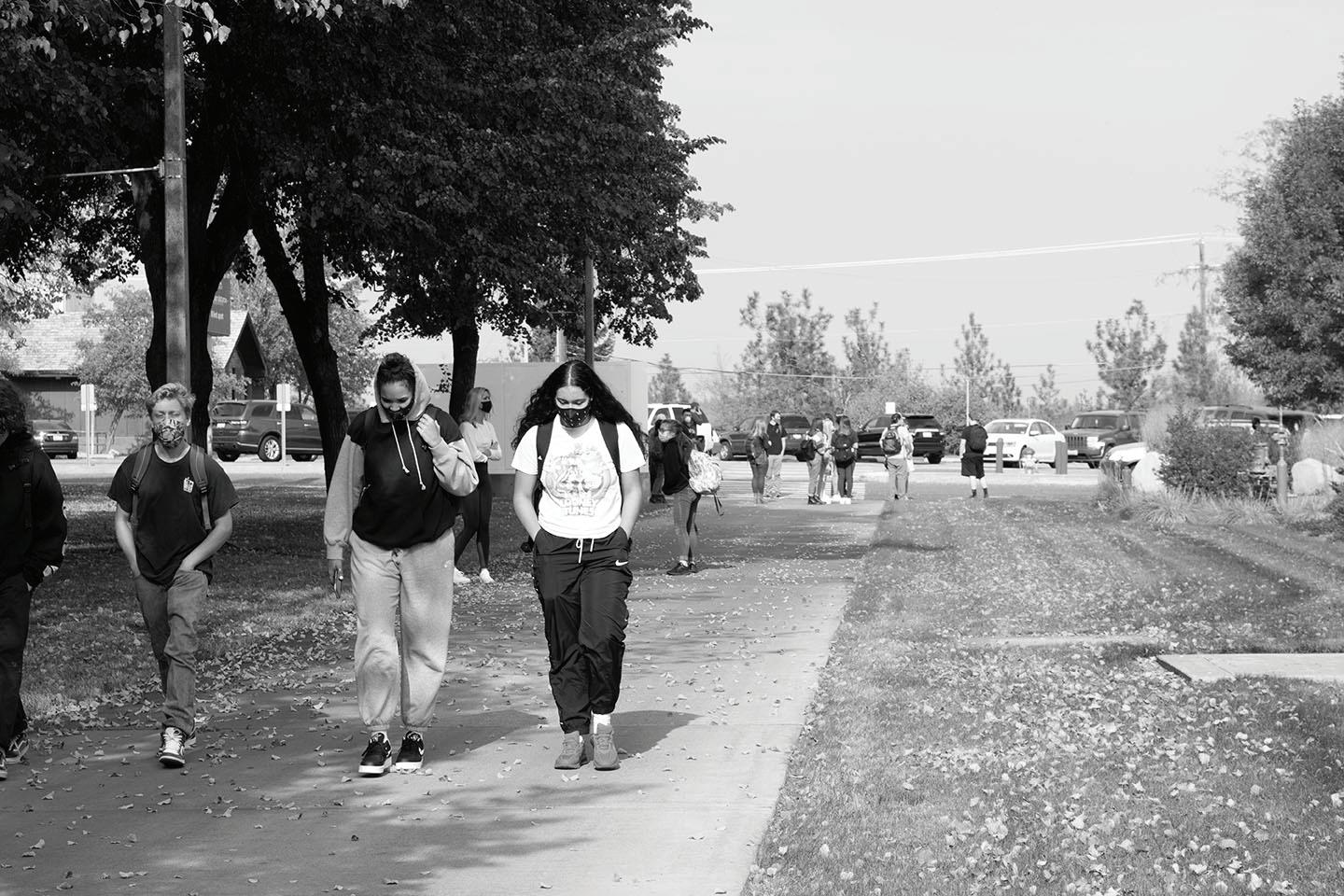
8 minute read
LOCATIONS AND TIPS FOR GETTING INVOLVED IN STARGAZING
sfcc.marisa.west@gmail.com ASTRONOMY IN SPOKANE
LOCATIONS AND TIPS FOR STARGAZING
Advertisement
DARIEN QUINN COMMUNICATOR
When the sun sets and the night sky rises, a show starts where the celebrities are stars and planets. Any clear night is a perfect time to look up in the sky and be fascinated by the night sky. With just a naked eye the International Space Station can be seen orbiting Earth at 17,000 MPH with its distinct shape and speed. Neighboring planets in our solar system are seen with ease thanks to the red and yellow hues they produce. On some nights a shooting star or a comet traveling by Earth is captured by the Space Station.
Astronomy is easy to get into with a lot of information posted online by amatuer astronomers and professional astonomers that work at NASA. NASA discuses when and where certain planets can be seen.
“I would suggest using a computer program like Starry Night or a phone app like Google Sky to begin the process of learning the sky,” said Astronomy professor, John Whitmer. “Then progress to a good pair of binoculars for viewing fainter objects.”
A phone will allow anyone to get a good direction on where to look when looking for planets or a certain star.
“The telescope I use has very powerful optics and requires a pickup to transport because of its size,” said Ravin Iron, an astronomer based in Colorado. “It’s powerful enough to capture moons transferring across Jupiter.”
Just looking up in an area with good visibility of the night sky will allow anyone to see most bright objects in the sky, but to get the best visibility you want to go to a place with little light pollution. In the Spokane area, John Whitmer, Astronomy Instructor at SFCC, recommended Fishtrap Lake just 30 minutes southwest of Spokane.
“This is far enough out of town to eliminate most light pollution, and there is a large public parking area at the lake with low horizons all around,” said Whitmer. “You can easily see the Milky Way from this location, which is difficult to see from the Spokane area.”
SFCC offers Astronomy courses that utilize the planetarium for computer generated demonstrations. In pre-COVID-19 times the planetarium hosted educational shows that talked about black holes, the history of our solar system, and stars of all sizes.
DEREK TRESNER | COMMUNICATOR Science observatory building teaches the stars.
STEM APPS TO HELP LEARN
MANY APPS AND WEBSITES ARE POPPING UP TO HELP STUDNETS.
DARIEN QUINN COMMUNICATOR
With the current COVID-19 pandemic, learning has been difficult for many teachers and students. Learning in an online environment has brought a lot of students out of their comfort zones and it can be difficult to learn in these conditions.
Students in STEM fields might find it even more difficult since a lot of science and math classes rely heavily on in person learning. The COVID-19 pandemic means students can’t be taught with a teacher in front and stay after class for questions. Exposure possibilities have meant students can’t form the study groups that a lot of students rely on for help and guidance from fellow students.
There are many educational websites and apps students can use that will be able to provide assistance in online learning environments. Khan academy is great for math and science subjects. They go over important sections of each subject like a class textbook would. Instructors show visual concepts on the screen and walk through a step by step process.
“Khan academy has been helpful since I only see my teacher twice a day,” said high school student Ryan Quinn. “ I like how they break down the problem and give quizzes to make sure you understand how to solve the problems.”
Symbolab is an equation solver that shows step by step solutions to algebra and calculus problems

CORBIN WILLMORTH | COMMUNICATOR KAHN academy offers resources to struggling students.
Symbolab provides names of steps that the student can learn about or review that can make solving problems easier. It alsohas a free website, but requires a membership for the mobile version.
COVID-19’s type of learning may be difficult, but there are resources that can help in this difficult learning environment.
COVID-19 CASES FOR WINTER QUARTER
Kalyn Sande COMMUNICATOR
Each Monday morning, the Community Colleges of Spokane reports the number of COVID-19 cases, updated weekly, in their employee newsletter.
“We report our number of COVID-19 cases every Monday morning in our employee newsletter,” said Communications director, Lorraine Nelson.
Two weeks ago, this is the report that came out for SFCC:
“As of Friday, Jan. 22, at 3 p.m, Spokane Falls Community College reported 8 COVID-19 cases since January 4, the first day of winter quarter,” Nelson said.
There is a statement in their newsletter that is in place to let people know who is included in the report of COVID-19 cases for CCS. It states that it is the number of confirmed cases reported from employees and students who have been in CCS district offices or campuses while being contagious. The number doesn’t include those who have not been to CCS offices or campuses. They also don’t include Head Start/ ECAP/Early Head Start infants and children, nor students at the Airway Heights Correctional Facility.
At the other college, Spokane Community College (SCC), there have been 9 cases since the start of winter quarter on January 4, and in the rest of the District there have been 6 cases. That being said, as of January 22 at 3 p.m., a total of 23 cases have been reported since the start of the quarter. By comparison, there have been a total of 25 cases in the entire district, which includes both colleges, during all of fall quarter from September 21 through December 11.
After getting updated results on Feb. 5th, 2021 at 3 p.m., this is what it looked like:
“As of 3 p.m. today, SFCC has had 18 COVID-19 cases since January 4; SCC has had 19: the District - which includes the Head Start employees as well as those in the central administrative offices - has had 7,” replied Nelson.
In just one week, the community colleges both had an increase in cases by 10 since January 4th, the start of winter quarter. The rest of the district only had one other since the last report came out.
As far as someone testing positive for COVID-19, returning to campus goes two different ways. There are checklists that are reviewed to make decisions on this.
“These are the checklists that we refer to constantly as we gather the information and decide when a quarantine is necessary, and then when the student can return,” said McCall Fadeley, executive assistant to the vice president of student

CORBIN WILLMORTH| COMMUNICATOR Photo of students walking and wearing masks on SFCC
services.
The number of days before you can return to campus after testing positive for COVID-19 can go two ways. If you show symptoms, you have to be away longer than if you don’t, in case you start to develop symptoms later on. Showing symptoms is 10 days of isolation before returning and no symptoms is 14 days. If someone is fever free for 24 hours after the 10 days without using fever reducing-medications and all symptoms have gone away, they can return to campus. For the 14 days, someone can return after those two weeks if they are symptom free.
STUDENTS’ THOUGHTS ON U.S. POLITICS
How are students handling recent changes in politics?
Corbin Willmorth COMMUNICATOR
With our nation’s ever changing political climate, one must ask: How are young people reacting to this?
The first three weeks of January 2021 was consequential for US Politics. There was the event at The Capitol Building on Wednesday the 6th, the second impeachment of 45th President Donald J. Trump on Wednesday the 13th, and the inauguration of 46th President Joseph R Biden on Wednesday the 20th. Not to mention that both the Senate and the House of Representatives are majority members of the Democratic Party.
As polling draws close in times of election, many outlets claim that it is important for young people to get out and vote. Though, many question why it about [the event at the Capital],” said student Cody Karuza. “On one hand, I think that it’s okay is that young people are always for people to exercise their rights encouraged to vote. What comes to talk back against the governto mind when students are asked ment. On the other hand, I don’t about their thoughts on US Poli- feel as though [the actions they tics? took] were entirely justified.” “I am excited about [Biden’s “Although, I am defi“My main thing is that [the event at Presidency],” said student Annica Honsaker. “Alnitely prepared to hold Biden to that the Capital] is going to eventually lead to legislation issues,” though, I am defi nitely prepared to hold Biden to - same amount of accountability [that said student Noah Rauser. “I feel that [these issues] are that same amount of accountability was held to Trump].” going to cause further restrictions later [that was held to on because of the Trump].” things that happened
“I don’t know how [Trump] at the Capital. The whole thing wasn’t evicted from office,” said was about protecting our rights student Grace Flat. “Pence would and exercising our right to protest have at least had some dignity. I against the government, but I feel mean, I don’t like the guy, but I that it’s going to lead to more feel like he would have not said legislation that effectively dilutes stupid things as much.” that more in the future.”
“I have conflicted feelings Youth, college students particularly, are important to the political process. According to Center for Information & Research on Civic Learning and Engagement (CIRCLE), 52-55% of people aged 18-29 voted in the 2020 election, which is about 30 million people. With Biden receiving 82 million votes and Trump receiving 74 million, this shows that the youth vote alone equaled between 37% and 41% of the votes to each candidate. Politics as a whole is an incredibly touchy subject, no matter the age group. While those much older will always have their say about how ‘young people should stay out of politics because they don’t know what they’re talking about,’ it’s clear to see that young people have opinions that, much like those of the older generation, vary. When it comes to opinions of politics, much hasn’t changed from generation-to-generation.



